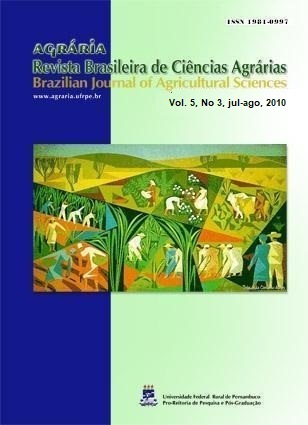Response of melon grown in Quartzarenic Neosol, to different sources and doses of phosphorus
DOI:
https://doi.org/10.5039/agraria.v5i3a599Keywords:
Chapada do Apodi, Cucumis melo, fertilization, natural phosphateAbstract
The objective of this study was to evaluate the effect of different sources and doses of phosphate fertilizers on the nutrient content of crop melon grown in a continuously fertilized Orthic Latosol Quratzarenic Neosol, at Chapada do Apodi, Rio Grande do Norte, Brazil. The study was carried out in the experimental area of the company “Agrícola Cajazeiras”, located in Icapuí, Ceara, Brazil, in 2002. The treatments consisted of the application of increasing doses of phosphorus (0, 80, 160, 240 and 320 kg ha-1 P2O5) in the sources: 1) Natural Phosphate Gafsa-GF (Tunisia), 2) Natural Phosphate Fosbahia-FB (Brazil); 3) Single Superphosphate-SS, and 4) Triple Superphosphate-ST. Yellow-hybrid Gold Mine melon was used as test plant. Phosphorus levels in the soil samples ranged from 105 to 147 mg dm-3. Split block design was used in the experiment. Tissues of the aerial part of the plant were evaluated by checking the levels of N, P, K, Ca, Mg, S, Na, Fe, Zn, Mn and Cu of the petiole and leaf blade. It was concluded that the use of natural P sources such as fosbahia and Gafsa in a continuously fertilized Orthic Latosol Qurtzarenic Neosol is a viable alternative compared to very soluble sources, such as triple and simple super phosphate. On the other hand, the application of high levels of phosphate fertilizers in continuously fertilized Orthic Latosol Quartzarenic Neosol leads to negative correlations between the Mg and Ca leaf levels and melon productivity.



